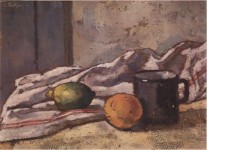TITΛΟΣ ΕΡΓΟΥΝΕΚΡΗ ΦΥΣΗ
ΔΙΑΣΤΑΣΕΙΣ ΕΡΓΟΥΎψος : 32.5
Πλάτος : 44.6
ΥΛΙΚΟ ΚΑΤΑΣΚΕΥΗΣΕλαιογραφία (Λάδι σε χαρτόνι)
ΥΠΟΓΡΑΦΗ ΚΑΛΛΙΤΕΧΝΗΠάνω Αριστερά
ΧΡΟΝΟΛΟΓΗΣΗ01-01-1909 - 31-12-1911
ΕΛΕΓΧΟΣ ΓΝΗΣΙΟΤΗΤΑΣΔεν έχει ελεγχθεί

Provenance:
Private collection, Athens.
Exhibited:
Thessaloniki, 19th Demetria, organized by the Vafopoulio Cultural Center and the National Gallery and Alexander Soutzos Museum, October-November 1984, no 37 (illustrated in the exhibition catalogue, no 19).
Athens, Federation of Greek Industries, Parthenis, June 2004 (illustrated in the exhibition catalogue, p. 15).
A work of colouristic dynamism and compositional austerity, this still life by the greatest 20th century Greek artist, represents a firm and personal statement eloquently illustrating his quest for new expressive ideas that would liberate Modern Greek painting from the pictorial conventions of the academic tradition.
Against an aggressively spaceless frontal plane and a wilfully flat background, a simple arrangement of enamelware, fruit and cloth becomes a fertile field of exploration and an ideal vehicle for Parthenis to investigate complex formal issues and project his own illusions of volume and space. Symmetrically placed vertical elements - the mug on the lower right and the door or cupboard on the upper left - act as stabilizing forces, anchoring the horizontal arrangement. Moreover, Still life is a penetrating study in colour contrasts and harmonies, producing a masterly juggling act in which objects are at once floating and weight-bound. The eye jumps from the juicy lemon, whose greenness is repeated in the textured wall, to the luscious orange and the dark cup, whose rich colours are echoed on the tabletop and the door (or cupboard) respectively. Parthenis models these still-life objects not through tonal gradations but through close juxtapositions of varied hues evoking tactile roundness. An intensely continuous black contour isolates each object, alluding to an archetypal world of pure forms and recalling the simple, linear definition of 'cloisonism', the cloisonné enamel-like style that emerged in the work of Bernard, Van Gogh and Gauguin in the late 1880s.
This painting probably dates from 1909-1914, when, according to Y. Kolokotronis, a scholar of still life in Modern Greek art, Parthenis "shows his admiration for Gauguin and Cezanne, rather than for other masters, such as Renoir. In his vividly painted still lives of this period, dominated by strong blues, yellows and greens, the artist, more than anything else, is interested in colour and in handling form through colour. While his post-1920 output is synthetic and technical, the austere architectural structure that distinguishes his works before 1914 is painterly and Cezannesque."1 Parthenis continued to construct and solve pictorial problems posed by still life until late in his career, declaring "painting interprets the objects and portrays my emotional judgment."2
1. Y. Kolokotronis, Still Life in Modern Greek Art from the 19th Century to Date (doctoral dissertation) [in Greek], Athens 1992, pp. 79-81.
2. E. Fertis, 'C. Parthenis, the Master' [in Greek], Zygos magazine, no. 11-12, September-October 1956, p. 26.